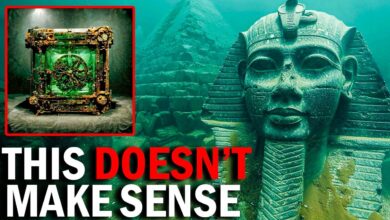New Evidence About Antediluvian People! We Really Did Experience The Great Flood?

New Evidence About Ancient Civilizations: Did the Great Flood Actually Happen?
Imagine everything we thought we knew about Stonehenge being turned upside down. Recent discoveries have challenged long-held assumptions about this ancient monument, which has puzzled historians and archaeologists for centuries. Who built it? How did they manage such a feat? And most importantly, why?
One of Stonehenge’s most remarkable features is the six-ton “altar stone” at its center. For years, researchers believed this stone, like many others in the structure, originated in Wales—an impressive feat considering the 140-mile journey to Wiltshire. However, new testing reveals something astonishing: the altar stone actually came from 650 miles away in northern Scotland. This revelation raises even bigger questions: If ancient civilizations were thought to lack advanced technology, how could they have transported these enormous stones over such vast distances of land and sea? How were they able to construct a site like Stonehenge with such precision, connecting regions separated by hundreds of miles?
Before diving into theories about how such ancient structures were built, let’s explore other mysterious monuments from the antediluvian period—structures that defy explanation even today. By the end, the question might not be “who built them” but rather, “how could they possibly have been built at all?”
The Great Sphinx of Giza
The Great Sphinx of Giza is one of the most iconic monuments in the world. While historians generally date it to around 3,000 BC, some scholars believe it may be far older—potentially dating back to 11,000 BC or earlier. Intriguingly, the weathering on the Sphinx’s surface isn’t consistent with desert sand or wind erosion. Instead, it appears to have been caused by water—heavy rainfall or even complete submersion. This has led some to connect the Sphinx with the story of a great flood, a tale that appears in many ancient cultures and in the Book of Genesis. Whether one believes in the biblical story of Noah’s Ark or not, the evidence of water damage on a monument located in one of the driest regions on Earth is difficult to ignore. But this still leaves the question: Who could have built such a structure, and why?
The Yonaguni Monument
Moving underwater, the Yonaguni Monument, discovered off the coast of Japan in 1986, presents another enigma. Initially dismissed as a natural rock formation caused by seismic activity, closer inspection reveals symmetrical steps, terraces, and pathways—features that seem far too precise to be accidental. The site even includes large stones resembling pyramids. Furthermore, like the Sphinx and Stonehenge, the Yonaguni Monument aligns with “ley lines”—an ancient grid of electromagnetic energy believed to connect sacred sites around the world. The Pyramids of Giza also align with these lines and are positioned with remarkable precision relative to the stars in Orion’s Belt.

The Callanish Stones
On Scotland’s Isle of Lewis stands another mysterious site: the Callanish Stones, which predate both Stonehenge and the Pyramids of Giza, dating back to around 2,900 BC. What makes the Callanish Stones extraordinary is their alignment with the lunar cycle, demonstrating an advanced understanding of astronomy long before modern tools existed. Beyond being an arrangement of rocks, the site functions as a natural observatory, offering stunning views of the northern lights. This precise alignment suggests the builders had a sophisticated knowledge of celestial movements. It challenges the assumption that ancient civilizations were primitive and hints at the possibility that they possessed advanced knowledge far beyond what we typically attribute to them.
Ley Lines and Geomagnetic Energy
A recurring theme among these ancient sites is their alignment with ley lines—geomagnetic pathways that form an interconnected energy grid across the Earth. Stonehenge, the Pyramids of Giza, and the Callanish Stones all lie directly on these lines. Could the builders have been aware of this energy and deliberately positioned their structures to harness it? Nikola Tesla once theorized about using Earth’s natural energy fields for wireless power transmission. Could ancient civilizations have possessed similar knowledge? Some theorists suggest these sacred sites amplified energy, while others speculate they might even serve as portals or points of connection between worlds. Although these ideas may sound far-fetched, they offer intriguing explanations for why so many ancient monuments seem deliberately placed along these invisible energy lines.
Giants in Myth and History
Local legends surrounding the Callanish Stones add another layer of mystery. Folklore describes the stones as once-living beings—giants who were turned to stone when they rejected biblical teachings. Variations of the tale portray them as pagan villagers or druids, enchanted and waiting for a prophecy to be fulfilled. Interestingly, the concept of giants isn’t limited to Scottish folklore. Cultures worldwide have passed down stories of massive beings who lived alongside humans, often credited with building monumental structures. Ancient Mesopotamian texts, Native American legends, and even the Bible mention giants. Genesis 6:4, for example, references the Nephilim: “There were giants on the earth in those days… mighty men of old, men of renown.” These beings are described as powerful and influential, capable of shaping the world around them.
The idea that giants built iconic structures like Stonehenge, the Callanish Stones, and the Pyramids raises questions about how ancient people—without advanced technology—could have moved massive stones across vast distances. Could these feats have been achieved through an advanced understanding of engineering or sheer physical strength beyond human capability?
Ancient Knowledge and Longevity
The mysteries of these monuments may not only lie in their construction but in the knowledge possessed by their builders. The Bible describes early humanity as living for hundreds of years. Figures like Methuselah, Enoch, and Adam lived for centuries, accumulating vast amounts of wisdom. In a world where people spoke a single language, knowledge could be shared easily, creating a continuous chain of learning across generations. This suggests that ancient societies were far more advanced and interconnected than we often assume.
A Biblical Perspective
The Bible teaches that humanity was originally created for eternal life, but sin introduced death into the world. Even so, God’s plan for redemption remains unshaken. Through Jesus Christ, who conquered death through His resurrection, humanity is offered the hope of eternal life. Ancient monuments may hold clues to this deeper truth—pointing us toward the Creator’s design and humanity’s purpose in the grand scheme of history.








